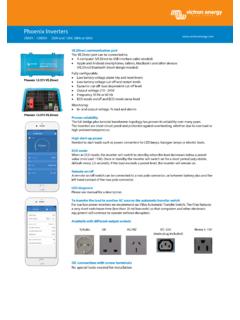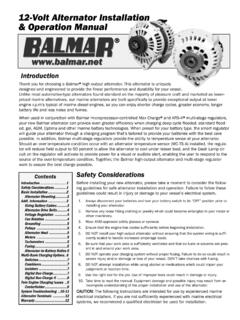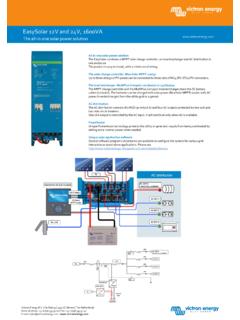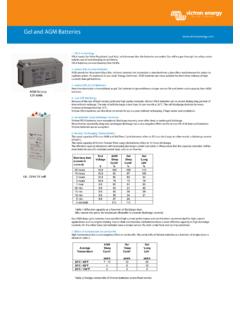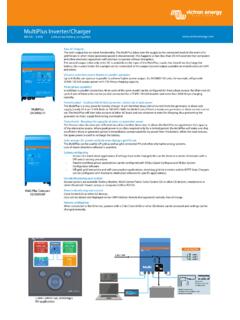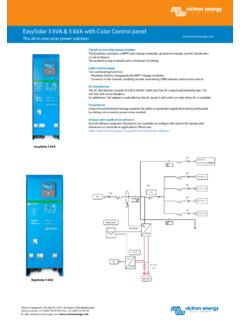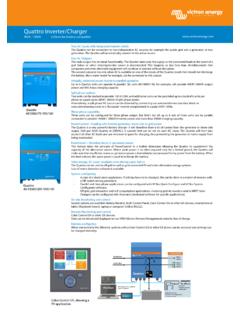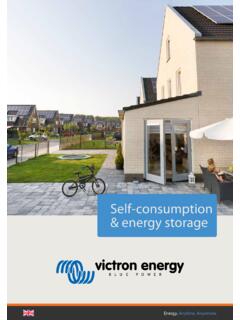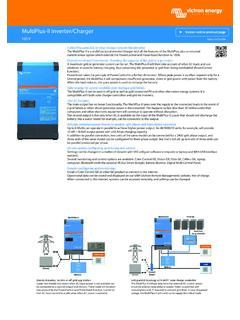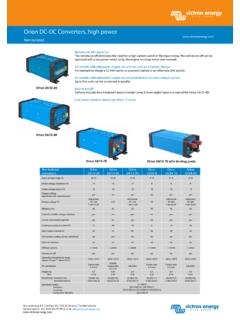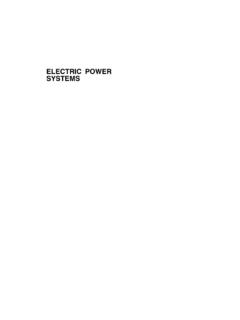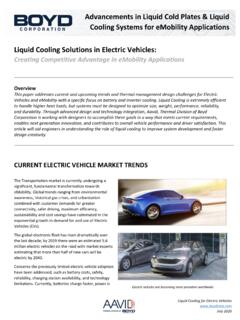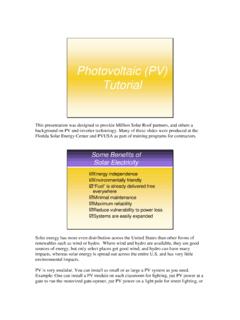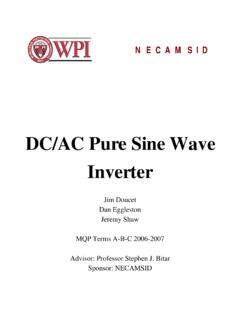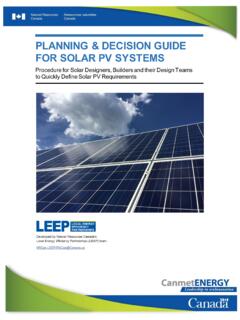Transcription of Wiring Unlimited - Rev 06 1 - Victron Energy
1 Wiring Unlimited - Rev 07 1 Wiring Unlimited - Rev 07 2 Wiring Unlimited Contents 1. Introduction .. 4 Safety warnings .. 4 Disclaimer .. 4 2. Theory .. 5 Ohm s Law .. 5 Power .. 5 Conductivity and resistance .. 6 Current, cable resistance and voltage drop .. 8 Negative effects of cable voltage drop .. 11 Ripple .. 12 3. Battery bank Wiring .. 16 Battery bank .. 16 Large battery banks .. 17 Parallel battery bank Wiring .. 18 Battery bank balancing .. 20 Battery bank midpoint .. 21 4. DC Wiring .. 23 Select the right 23 Busbars .. 26 Cable connections .. 27 Fuses and circuit breakers .. 30 DC isolation switches .. 34 Shunt .. 35 Parallel and/or 3 phase system DC Wiring .. 37 Large system busbars .. 38 Voltage sensing and compensation .. 39 Solar panels.
2 41 5. Communication Wiring .. 45 Data signals .. 45 Interference .. 45 Communication cables and connector types .. 46 Interfaces .. 48 6. AC Wiring .. 49 Power generation .. 49 Distribution networks .. 49 Wiring Unlimited - Rev 07 3 System current VA and 50 AC Wiring .. 52 Fuses and circuit breakers .. 53 AC bypass switch .. 53 Special considerations for AC Wiring of parallel and/or 3 phase inverter/chargers .. 54 7. Ground, earth and electrical safety .. 56 Electrical safety .. 56 Earth Wiring .. 58 RCD .. 58 Neutral to earth link in inverters and in inverter/chargers .. 59 Mobile installations .. 60 Isolation and grounding of Victron Equipment .. 63 System grounding .. 64 8. Galvanic corrosion .. 66 Preventing galvanic corrosion .. 66 The galvanic isolator.
3 67 The isolation transformer .. 68 9. Credits .. 69 Wiring Unlimited - Rev 07 4 1. Introduction Welcome to Wiring Unlimited , a book about electrical Wiring of systems containing batteries, inverters, charger and inverter/chargers. With this book we aim to explain Wiring basics of electrical systems. We will explain the importance of getting it right and the issues that might result if a system has inferior Wiring . It also assists electrical installers or users to troubleshoot issues that have arisen from bad Wiring . This so correct conclusions can be drawn for the electrical systems they are involved with. Wiring issues are often a cause of system problems, or they can lead to underperformance of systems. For a trouble-free operation of any electrical system and particularly those systems that contain an inverter/charger and batteries which are 'high-current' devices, it is essential that the Wiring of the system is done correctly.
4 This book will help you with getting it right . Safety warnings Electricity is dangerous. It can cause harm to persons or property. It takes a remarkably small amount of current across the human heart to stop it. Due to the natural resistance of the human skin and tissue this means that a high voltage is required to generate this heart-stopping current. But humans have died at as low as 42 Volt. Both DC and AC can cause this fatal occurrence. Electrical work should therefore always be carried out by a qualified electrician or technician and the local safety guidelines and requirements need to be adhered to. IMPORTANT: AC and DC voltages are dangerous and harmful. Always use insulated tools when working with electricity and batteries. Do not short circuit batteries this can cause fire or explosion.
5 Battery charging can create explosive gasses. Undersized Wiring or bad electrical contact can cause fire. Disclaimer The sole purpose of this document is to aid in the understanding of basic principles behind certain electrical concepts. This document is intended as a guide only. Electrical Wiring regulations can be different based on where you are in the world. Local electrical regulations can differ from the Wiring advice given in this document. It is your responsibility to always seek professional advice and instruction from local authorities and/or licensed electricians prior to undertaking any electrical work. Wiring Unlimited - Rev 07 5 2. Theory You will get the most out of this document if you have knowledge of basic electrical theory. This will help you to understand the underlying factors that determine Wiring thickness and fuse ratings.
6 You might already have this basic understanding and can perhaps skip this chapter, but we highly recommend that you at least have a read. Ohm s Law Ohm s law is the most important law of an electric circuit. It is the basis of almost all electrical calculations. It allows you to calculate the current that runs through a cable (or a fuse) at different voltages. Knowing how much current runs through a cable is essential knowledge to be able to choose the correct cable for your system. But first some electricity basics are needed. Electricity is movement of electrons in a material, called a conductor. This movement creates an electric current. This current is measured in ampere (amps for short) and the symbol is A. The force required to make the electrons flow is called voltage (or potential). It is measured in volt and the symbol is V (In Europe also referred to as U).
7 When an electrical current passes through a material, it meets a certain resistance. This resistance is measured in Ohm. The symbol is . Voltage, current and resistance are related to each other. When the resistance is low, many electrons move, and the current is high. When the resistance is higher, less electrons move, and the current is lower. When the resistance is very high, no electrons move at all, and the current has stopped. You can say that the resistance of a conductor determines how much current runs through a material at a given voltage. This can be represented in a formula. The formula is called Ohm s Law: Power Ohm s law describes the relationship between resistance, current and voltage. But there is one more electrical unit that can be derived from Ohm s law and this is Power.
8 Power is an expression of how much work an electric current can do. It is measured in Watts and the symbol is P. It can be calculated using the following formula: Current (A) = Voltage (V) / Resistance ( ) I = V/R P = I x V Wiring Unlimited - Rev 07 6 From Ohm s law other formulas can be derived. All possible formulas are listed in the image on the right. Please note that there are two symbols in use in the world that represent Voltage. These are U or V. Some of these formulas are very useful when calculating current in cables. One often used formula is : This formula lets you calculate how much current runs through a cable when the voltage and the power is known. An example of how this formula can be used: Question: If we have a 12V battery that is connected to a 2400 W load. How much current is running through the cable?
9 Answer: V = 12 V P = 2400 W I = P/V = 2400/12 = 200 A A big advantage of using power in calculations or for measurements is that power is independent of voltage. This is useful in systems where multiple voltages exist. An example of this would be a system with a battery, mains power and perhaps a solar panel. Power remains the same across the different voltages. For example, if you run an AC load of 2400 W via an inverter from a 12 V battery it will also take 2400 W from the battery (ignoring the inverter inefficiencies). Conductivity and resistance Some materials conduct electricity better than other materials. Materials with a low resistance conduct electricity well, and materials with a high resistance conduct electricity poorly, or not at all. Metals have a low resistance and they conduct electricity well.
10 These materials are called conductors. This is the reason they are used in electrical cables. Plastic or ceramics have a very high resistance, they do not conduct electricity at all. They are called insulators. This is why non-conductive materials, like plastic or rubber, are used on the outside of cables. You will not get an electrical shock when you touch the cable because electricity cannot travel through this material. Insulators are also used to prevent short circuit when two cables touch each other. I = P/V 2400 W230 AAC Load2400 W12 V200 AWiring Unlimited - Rev 07 7 Each material has its own specific resistance. It is measured in .m. and the symbol is (rho). The table on the right lists various conducting materials, their electrical conductivity and their specific resistance.
